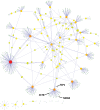The TRiC/CCT chaperone is implicated in Alzheimer's disease based on patient GWAS and an RNAi screen in Aβ-expressing Caenorhabditis elegans
- PMID: 25080104
- PMCID: PMC4117641
- DOI: 10.1371/journal.pone.0102985
The TRiC/CCT chaperone is implicated in Alzheimer's disease based on patient GWAS and an RNAi screen in Aβ-expressing Caenorhabditis elegans
Abstract
The human Aβ peptide causes progressive paralysis when expressed in the muscles of the nematode worm, C. elegans. We have exploited this model of Aβ toxicity by carrying out an RNAi screen to identify genes whose reduced expression modifies the severity of this locomotor phenotype. Our initial finding was that none of the human orthologues of these worm genes is identical with the genome-wide significant GWAS genes reported to date (the "white zone"); moreover there was no identity between worm screen hits and the longer list of GWAS genes which included those with borderline levels of significance (the "grey zone"). This indicates that Aβ toxicity should not be considered as equivalent to sporadic AD. To increase the sensitivity of our analysis, we then considered the physical interactors (+1 interactome) of the products of the genes in both the worm and the white+grey zone lists. When we consider these worm and GWAS gene lists we find that 4 of the 60 worm genes have a +1 interactome overlap that is larger than expected by chance. Two of these genes form a chaperonin complex, the third is closely associated with this complex and the fourth gene codes for actin, the major substrate of the same chaperonin.
Conflict of interest statement
Figures





References
-
- Gatz M, Pedersen NL, Berg S, Johansson B, Johansson K, et al. (1997) Heritability for Alzheimer’s disease: the study of dementia in Swedish twins. J Gerontol A Biol Sci Med Sci 52: M117–25. - PubMed
-
- Gatz M, Reynolds CA, Fratiglioni L, Johansson B, Mortimer JA, et al. (2006) Role of genes and environments for explaining Alzheimer disease. Arch Gen Psychiatry 63: 168–174. - PubMed
-
- Goate A, Chartier-Harlin MC, Mullan M, Brown J, Crawford F, et al. (1991) Segregation of a missense mutation in the amyloid precursor protein gene with familial Alzheimer’s disease. Nature 349: 704–706. - PubMed
-
- Selkoe DJ (2001) Alzheimer’s disease: genes, proteins, and therapy. Physiol Rev 81: 741–766. - PubMed
Publication types
MeSH terms
Substances
Grants and funding
- MR/K013041/1/MRC_/Medical Research Council/United Kingdom
- WT089703AIA/WT_/Wellcome Trust/United Kingdom
- G0601840/MRC_/Medical Research Council/United Kingdom
- G0700990/MRC_/Medical Research Council/United Kingdom
- 089703/WT_/Wellcome Trust/United Kingdom
- MR/L501517/1/MRC_/Medical Research Council/United Kingdom
- G0902227/MRC_/Medical Research Council/United Kingdom
- 082604/2/07/Z/WT_/Wellcome Trust/United Kingdom
- G0300429/MRC_/Medical Research Council/United Kingdom
- G1002610/MRC_/Medical Research Council/United Kingdom
- MR/L010305/1/MRC_/Medical Research Council/United Kingdom
- 100140/WT_/Wellcome Trust/United Kingdom
- MC_G1000734/MRC_/Medical Research Council/United Kingdom
- G0901786/MRC_/Medical Research Council/United Kingdom
LinkOut - more resources
Full Text Sources
Other Literature Sources
Medical

